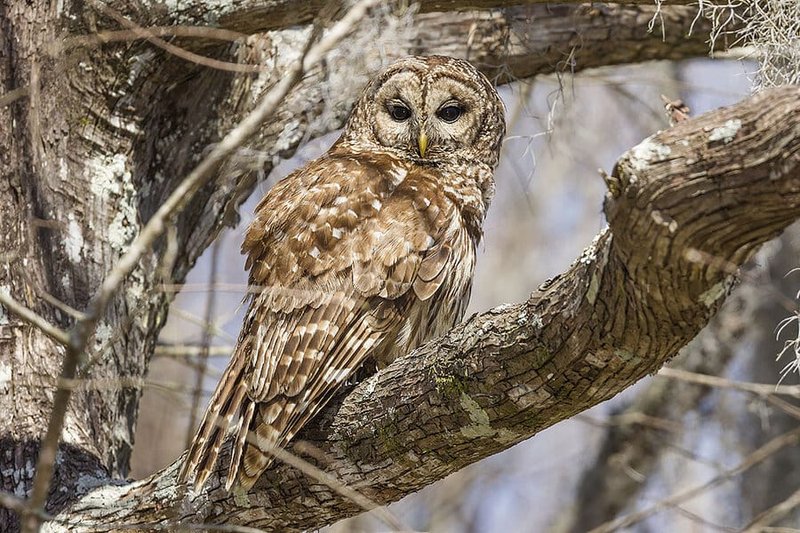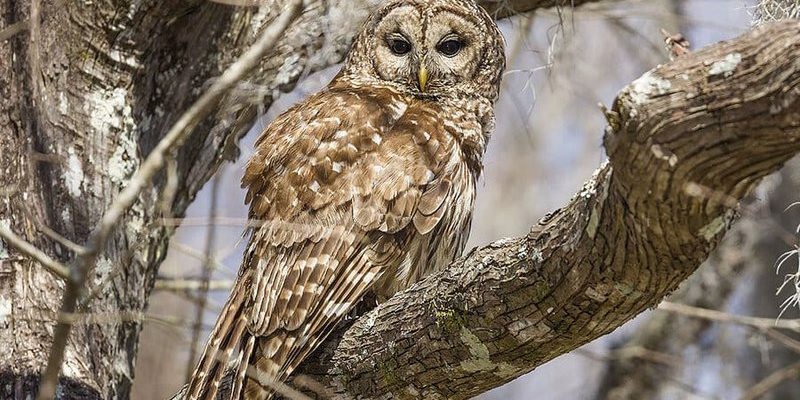
Barred Owls are not just your average birds; they have a rich history and unique traits that make them stand out. From their striking features to their unusual behaviors, these owls can be a source of endless curiosity. So, let’s explore 10 interesting facts about the Barred Owl that might just surprise you!
1. Unique Appearance
When you first spot a Barred Owl, you can’t help but notice its charming look. These owls have a round face with a heart-shaped facial disc that gives them a wise and somewhat comical appearance. The color palette of a Barred Owl is equally fascinating, typically displaying a mix of brown and white feathers that are beautifully striped. This camouflage helps them blend into the trees, making them hard to spot during the day.
You might also notice their large, dark eyes that seem to hold the secrets of the night. Unlike many other owls, Barred Owls do not have ear tufts, which adds to their unique charm. It’s like they took a different path in the evolutionary journey of owls, opting for a more approachable look!
2. Distinctive Calls
One of the most recognizable features of Barred Owls is their distinctive hooting call. They often say “Who cooks for you? Who cooks for you all?” This call isn’t just a poetic way to ask for dinner; it’s a crucial part of how these owls communicate with each other. Think of it as their own version of texting—a way to say, “Hey, I’m here!” to other owls.
Not only do males and females call to each other, but they also have different calls that play various roles, like defending territory or attracting mates. It’s fascinating how such a simple sound can carry so much meaning in the wild!
3. Habitat and Distribution
Barred Owls are found primarily in the eastern United States and parts of Canada, but they can also be seen in the Pacific Northwest. They thrive in a mix of forested areas, swamps, and even regions near urban settings. Their adaptability to different habitats demonstrates just how versatile these birds can be.
They prefer older, mature forests, which provide ample nesting sites and hunting grounds. Imagine them as the ultimate forest dwellers, enjoying the comfort of trees that have stood tall for decades. When looking for a Barred Owl, keep an eye out for them roosting on low branches during the day, waiting for twilight to start their nightly activities.
4. Diet and Hunting Skills
Barred Owls are opportunistic hunters, meaning they have a varied diet that can change depending on what’s available. Their main meal consists of small mammals, birds, and even amphibians. This buffet of options makes them effective hunters.
What’s truly impressive is how proficient they are at hunting. Barred Owls rely on their keen eyesight and acute hearing to detect prey, even in complete darkness. They can hear the smallest rustle in the leaves, allowing them to swoop down with precision. It’s like they have a built-in night vision system that transforms them into nighttime predators.
5. Monogamous Behavior
When it comes to love, Barred Owls are generally monogamous, often forming long-lasting bonds with a single partner. Once they find their mate, they usually stick together for years, raising their young in the same territory. It’s kind of sweet, right?
During the nesting season, which usually occurs from late winter to early spring, both parents share the responsibility of caring for their young. They work together to hunt, feed, and protect their chicks, making them a true team. This level of cooperation is not only admirable but also crucial for the survival of the next generation of owls.
6. Nesting Habits
Barred Owls typically nest in tree cavities or use old nests built by other birds. They’re not too picky about their nesting locations, which is a blessing and a curse. While this flexibility helps them adapt, it can also lead them to nest in areas that are dangerous or prone to human disturbances.
The female usually lays two to three eggs, and she’ll incubate them for about 28 to 33 days. During this time, the male is busy bringing food to the nest, ensuring both mom and the little ones are well-fed. When the hatched chicks begin to grow, they leave the nest but stay close to their parents, learning important life skills before venturing out on their own.
7. Role in the Ecosystem
Every creature in nature has a role to play, and Barred Owls are no different. As apex predators, they help maintain the balance of their ecosystems. By keeping populations of small mammals and birds in check, they contribute to the health of their habitats.
Without these owls, certain species could become overpopulated, leading to a domino effect in the local ecosystem. It’s like they’re the keepers of balance, ensuring every creature has its place and role in the grand tapestry of life.
8. Conservation Status
Currently, Barred Owls are classified as a species of least concern, but that doesn’t mean they’re completely safe. Habitat destruction, climate change, and competition with other owl species—like the invasive Great Horned Owl—pose significant threats.
Conservation efforts are ongoing to protect their habitats and ensure these beautiful birds don’t face extinction. By raising awareness about their importance and encouraging practices that protect their environments, we can all play a part in helping Barred Owls thrive.
9. Fascination Beyond Nature
Barred Owls have made their mark not only in nature but also in culture and art. Many artists, writers, and filmmakers have been inspired by these creatures. Their haunting calls and beautiful plumage often symbolize wisdom and mystery. You may have come across stories or legends that feature owls, adding to their allure.
This cultural significance adds another layer to their fascinating existence. It’s like they’re not just animals; they’re a part of our storytelling traditions, weaving themselves into the fabric of our shared humanity.
10. How to Spot a Barred Owl
If you’re eager to catch a glimpse of a Barred Owl, here are a few tips to help you out:
- Visit wooded areas, especially during dusk or dawn when they’re most active.
- Listen for their characteristic calls; this can help you locate them.
- Bring binoculars for a closer look while maintaining a distance; this way, you won’t disturb them.
- Look for them perched low on branches, often near water sources.
With a bit of patience and a keen eye, you’ll be able to share a moment with these enchanting creatures!
In conclusion, Barred Owls are not just beautiful birds; they are essential parts of our ecosystems and rich sources of inspiration. As you explore the woods or listen to the lullabies of the night, remember the fascinating facts we’ve uncovered about these owls. By appreciating their role in nature, we can help ensure that they continue to grace our forests for generations to come.

